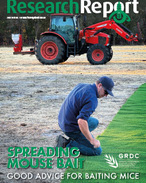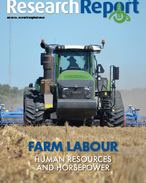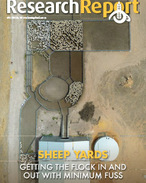Whether this indeed plays out or not is up for debate, with the Western Australian growers Bushwhacker has ran it past mostly remaining quite bullish on the medium term price outlook for the commodity.
This is despite significant carryover supplies remaining in storage and handling systems from last season's marketing campaigns and global supply for the coming year set to outstrip demand.
However, there are some outlier events playing out globally at the moment that have the potential to disrupt commodity markets (soft and hard) and results in prices perhaps not tracking strictly along the logical supply and demand curve predictions.
Among these variables are the quality and reliability of Russian supply targeting South East Asia, the variability of Chinese government policy around imports and Brexit disrupting European market dynamics.
Regardless of the underlying market conditions for wheat, it has been an exceptionally good (and early) start to the winter cropping season across key grain growing regions in Australia and talk has commenced around record breaking crops being delivered.
WA and Victoria are likely to add the most "extra" tonnes to the market, with the industry in WA, in particular, gearing up to knock off its previous best mark of 15.8 million tonnes in total of grain produced in 2014.
WA has had a bit of a run on the past three years, which has more than kept a the state's storage, handling and marketing network busy, while in Victoria the narrative is more around a recovery from poor seasonal conditions and below average yields last season.
Despite some growers hedging their bets to some degree in WA and spreading their mix of plantings to compensate for softening wheat prices, it appears the start has been so good and follow-up rainfall events so promising that the research types suggest overall wheat output could actually rise as a result of yield increases.
All that sounds pretty good, but it could create a few issues for WA around storage, handling and marketing, with CBH Group flagging it is preparing to open receival sites that have been closed in recent years.
This is an interesting situation for the organisation, particularly as it has this year made significant announcements around rationalising its network to a more centralised system to achieve greater overall efficiencies.
Exacerbating this is the fact the state's Tier 3 rail system, previously servicing the Wheatbelt, remains controversially closed, and that some of the capacity CBH might need to call in remains occupied by carryover grain for last season's marketing.
I am sure the nation's largest grain handling and storage business has the resources to solve the storage problem, but despite its prolonged best efforts has not been able to find a favourable solution with other stakeholders around reopening Tier 3.
I haven't heard much chatter about carryover wheat, in particular, being a significant issue until talk of record crops emerged, but inevitably it is yet another factor likely to put downward pressure on the price achieved by Australian growers when marketing this year's crop.
Forecasts are a tough game, but most agree that Australia's share of its largest wheat export market in South East Asia is likely to diminish, despite the fact consumption looks like continuing to grow, which is a result of lower shipping costs making northern hemisphere grain competitive in our neighbourhood.
Russian and Ukrainian exports have become a major source of supply in South East Asia, where weaknesses in exchange rates have also fuelled competitive tension, along with the fact those two markets enjoy a relatively low cost of production anyway.
It is important to note that most wheat being imported into South East Asia from Russia and its neighbours is destined to predominantly be used as animal feed.
This is where the Australian advantage may still prevail, given its reputation for quality food production albeit at a premium, but again it is just another obstacle to future price stability.




















ON-FARM
OPINION: When you want it to rain, but need it not to pour
Commentators predict a bumper wheat harvest, but could there be a sting in the tail?
This article is 9 years old. Images might not display.
Whether this indeed plays out or not is up for debate, with the Western Australian growers Bushwhacker has ran it past mostly remaining quite bullish on the medium term price outlook for the commodity.
This is despite significant carryover supplies remaining in storage and handling systems from last season's marketing campaigns and global supply for the coming year set to outstrip demand.
However, there are some outlier events playing out globally at the moment that have the potential to disrupt commodity markets (soft and hard) and results in prices perhaps not tracking strictly along the logical supply and demand curve predictions.
Among these variables are the quality and reliability of Russian supply targeting South East Asia, the variability of Chinese government policy around imports and Brexit disrupting European market dynamics.
Regardless of the underlying market conditions for wheat, it has been an exceptionally good (and early) start to the winter cropping season across key grain growing regions in Australia and talk has commenced around record breaking crops being delivered.
WA and Victoria are likely to add the most "extra" tonnes to the market, with the industry in WA, in particular, gearing up to knock off its previous best mark of 15.8 million tonnes in total of grain produced in 2014.
WA has had a bit of a run on the past three years, which has more than kept a the state's storage, handling and marketing network busy, while in Victoria the narrative is more around a recovery from poor seasonal conditions and below average yields last season.
Despite some growers hedging their bets to some degree in WA and spreading their mix of plantings to compensate for softening wheat prices, it appears the start has been so good and follow-up rainfall events so promising that the research types suggest overall wheat output could actually rise as a result of yield increases.
All that sounds pretty good, but it could create a few issues for WA around storage, handling and marketing, with CBH Group flagging it is preparing to open receival sites that have been closed in recent years.
This is an interesting situation for the organisation, particularly as it has this year made significant announcements around rationalising its network to a more centralised system to achieve greater overall efficiencies.
Exacerbating this is the fact the state's Tier 3 rail system, previously servicing the Wheatbelt, remains controversially closed, and that some of the capacity CBH might need to call in remains occupied by carryover grain for last season's marketing.
I am sure the nation's largest grain handling and storage business has the resources to solve the storage problem, but despite its prolonged best efforts has not been able to find a favourable solution with other stakeholders around reopening Tier 3.
I haven't heard much chatter about carryover wheat, in particular, being a significant issue until talk of record crops emerged, but inevitably it is yet another factor likely to put downward pressure on the price achieved by Australian growers when marketing this year's crop.
Forecasts are a tough game, but most agree that Australia's share of its largest wheat export market in South East Asia is likely to diminish, despite the fact consumption looks like continuing to grow, which is a result of lower shipping costs making northern hemisphere grain competitive in our neighbourhood.
Russian and Ukrainian exports have become a major source of supply in South East Asia, where weaknesses in exchange rates have also fuelled competitive tension, along with the fact those two markets enjoy a relatively low cost of production anyway.
It is important to note that most wheat being imported into South East Asia from Russia and its neighbours is destined to predominantly be used as animal feed.
This is where the Australian advantage may still prevail, given its reputation for quality food production albeit at a premium, but again it is just another obstacle to future price stability.
RELATED ARTICLES
TOPICS:
< PREVIOUS ARTICLE
OPINION: Reef flush with funds
NEXT ARTICLE >
OPINION: When you want it to rain, but need it not to pour
Get the Farming Ahead Newsletter delivered free each day
FROM OUR PARTNERS
PARTNER CONTENT
Drought, Fires, and Floods Haven't Stopped WA-Based Business Expansion
PARTNER CONTENT
Utrisha N: The new biostimulant boosting broadacre yield potential